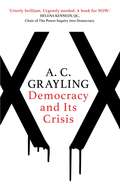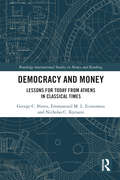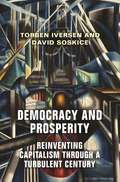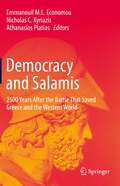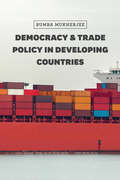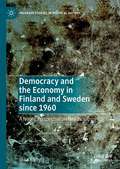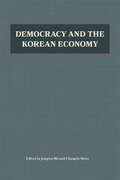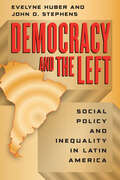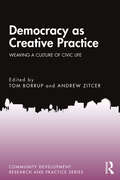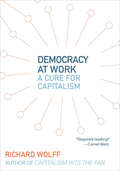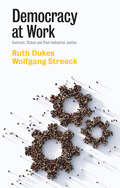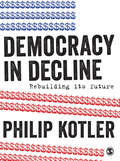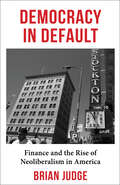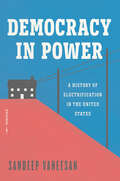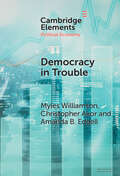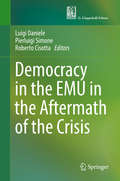- Table View
- List View
Democracy and Its Crisis
by A. C. GraylingThe EU referendum in the UK and Trump&’s victory in the USA sent shockwaves through our democratic systems. In Democracy and Its Crisis A. C. Grayling investigates why the institutions of representative democracy seem unable to hold up against forces they were designed to manage, and why it matters. First he considers those moments in history when the challenges we face today were first encountered and what solutions were found. Then he lays bare the specific threats facing democracy today. The paperback edition includes new material on the reforms that are needed to make our system truly democratic.
Democracy and Money: Lessons for Today from Athens in Classical Times (Banking, Money and International Finance)
by George C. Bitros Nicholas C. Kyriazis Emmanouil M. EconomouThe authors of this book argue that post-war fiscal and monetary policies in the U.S. are prone to more frequent and more destabilizing domestic and international financial crises. So, in the aftermath of the one that erupted in 2008, they propose that now we are sleepwalking into another, which under the prevailing institutional circumstances could develop into a worldwide financial Armageddon. Thinking ahead of such a calamity, this book presents for the first time a model of democratic governance with privately produced money based on the case of Athens in Classical times, and explains why, if it is conceived as a benchmark for reference and adaptation, it may provide an effective way out from the dreadful predicament that state managed fiat money holds for the stability of Western-type democracies and the international financial system. As the U.S. today, Athens at that time reached the apex of its military, economic, political, cultural, and scientific influence in the world. But Athens triumphed through different approaches to democracy and fundamentally different fiscal and monetary policies than the U.S. Thus the readers will have the opportunity to learn about these differences and appreciate the potential they offer for confronting the challenges contemporary democracies face under the leadership of the U.S. The book will find audiences among academics, university students, and researchers across a wide range of fields and subfields, as well as legislators, fiscal and monetary policy makers, and economic and financial consultants.
Democracy and Prosperity: Reinventing Capitalism through a Turbulent Century
by Torben Iversen David SoskiceA groundbreaking new historical analysis of how global capitalism and advanced democracies mutually support each otherIt is a widespread view that democracy and the advanced nation-state are in crisis, weakened by globalization and undermined by global capitalism, in turn explaining rising inequality and mounting populism. This book, written by two of the world’s leading political economists, argues this view is wrong: advanced democracies are resilient, and their enduring historical relationship with capitalism has been mutually beneficial.For all the chaos and upheaval over the past century—major wars, economic crises, massive social change, and technological revolutions—Torben Iversen and David Soskice show how democratic states continuously reinvent their economies through massive public investment in research and education, by imposing competitive product markets and cooperation in the workplace, and by securing macroeconomic discipline as the preconditions for innovation and the promotion of the advanced sectors of the economy. Critically, this investment has generated vast numbers of well-paying jobs for the middle classes and their children, focusing the aims of aspirational families, and in turn providing electoral support for parties. Gains at the top have also been shared with the middle (though not the bottom) through a large welfare state.Contrary to the prevailing wisdom on globalization, advanced capitalism is neither footloose nor unconstrained: it thrives under democracy precisely because it cannot subvert it. Populism, inequality, and poverty are indeed great scourges of our time, but these are failures of democracy and must be solved by democracy.
Democracy and Public Administration
by Richard C BoxThe true measure of the successful practice of public service is its ability to remain faithful to the tenets of democratic society. This introductory text links the practice of public administration to the core concepts of American democracy. It covers the nuts and bolts of public administration in the context of "delivering democracy" in public service - providing what the public really wants as opposed to what self-serving bureaucracies may call for. Chapters in "Democracy and Public Administration" discuss the functional topics covered in other texts, but from the perspective of this democratic ideal. Each chapter is written by an expert in the area, and summarizes previous research in the area, presents the author's research and thought, and offers ways in which practitioners can apply the concepts discussed to their daily work.
Democracy and Public-Private Partnerships in Global Governance
by Magdalena Bexell Ulrika MörthThere has been rapid proliferation of public-private partnerships in areas of human rights, environmental protection and development in global governance. This book demonstrates how different forms of partnership legitimacy and accountability interact, and pinpoints trade-offs between democratic values in partnership operations.
Democracy and Reforms: Evidence from a New Dataset*
by Antonio Spilimbergo Prachi Mishra Paola GiulianoA report from the International Monetary Fund.
Democracy and Salamis: 2500 Years After the Battle That Saved Greece and the Western World
by Nicholas C. Kyriazis Emmanouil M. L. Economou Athanasios PlatiasIn this book, well-renowned international scholars discuss topics related to various aspects of the history of the Battle of Salamis, inspired by the democratic origins of the Greek naval victory at Salamis. They present deductions from the battle that can be useful for today, and seek answers for a more prosperous and brighter future for our societies. Their analyses are divided into five parts in the book: 1) The democratic implications of the Battle of Salamis; 2) The strategies that lead to monumental naval victories; 3) The institutional implications of the Battle of Salamis; 4) Various societal aspects of the Athenian democracy; 5) The interconnections between two glorious battles: Thermopylae and Salamis. This book is the first out of two edited volumes as a sequel of an international academic conference titled Salamis and Democracy: 2500 Years After that took place between October 3rd and October 5th, 2020, on the occasion of the 2500th anniversary of the great historical event of the Battle of Salamis, which saved Greek culture and the newly founded democratic regimes throughout the Hellenic world during the Classical period (508-323 BCE). The book is a must-read for scholars and students of history, political science, economics, and law, as well as policy-makers interested in a better understanding of classical, ancient, and political history, democracy, strategy, governance, and social choice.
Democracy and Trade Policy in Developing Countries
by Bumba MukherjeeSince the 1970s, two major trends have emerged among developing countries: the rise of new democracies and the rush to free trade. For some, the confluence of these events suggests that a free-market economy complements a fledgling democracy. Others argue that the two are inherently incompatible and that exposure to economic globalization actually jeopardizes new democracies. Which view is correct? Bumba Mukherjee argues that the reality of how democracy and trade policy unravel in developing countries is more nuanced than either account. Mukherjee offers the first comprehensive cross-national framework for identifying the specific economic conditions that influence trade policy in developing countries. Laying out the causes of variation in trade policy in four developing or recently developed countries--Brazil, India, Indonesia, and South Africa--he argues persuasively that changing political interactions among parties, party leaders, and the labor market are often key to trade policy outcome. For instance, if workers are in a position to benefit from opening up to trade, party leaders in turn support trade reforms by decreasing tariffs and other trade barriers. At a time when discussions about the stability of new democracies are at the forefront, Democracy and Trade Policy in Developing Countries provides invaluable insight into the conditions needed for a democracy to survive in the developing world in the context of globalization.
Democracy and Women's Rights in America: The Fight over the ERA
by David A. Moss Dean Grodzins Amy Smekar Marc Campasano Rachel WilfOn the afternoon of June 21, 1982, the Florida Senate prepared to vote on whether to ratify the proposed Equal Rights Amendment (ERA) to the U.S. Constitution, which stated that "Equality of Rights under the law shall not be denied or abridged by the United States or by any State on account of sex." Supporters believed the ERA was essential to winning equal rights for women. Opponents claimed that the proposed amendment would dangerously expand federal power over the states, remove needed protections for women, and undermine the American family. When Congress had sent the ERA to the states for ratification, in March 1972, it had done so through a joint resolution stipulating that state legislatures had to ratify it within seven years. As the deadline neared, however, only 35 of the requisite 38 states had voted to ratify the amendment, four of which later voted to rescind ratification, though ERA supporters questioned the constitutionality of rescission. In October 1978, Congress extended the ratification deadline to June 30, 1982, a move that ERA opponents denounced as unconstitutional. Over the next several years, one more state voted to rescind, and no new states ratified. In 1982, ERA supporters made a final push for ratification. That June, the governor of Florida, an ERA supporter, called the state legislature into special session to consider, among other issues, approval of the ERA. If Florida ratified, supporters hoped that Illinois and either Oklahoma or North Carolina would quickly follow. On June 21, thousands of demonstrators, both for and against the amendment, converged on the state capitol in Tallahassee. That morning, the Florida House voted in favor of the ERA, 60 to 58. Now it was up to the Florida Senate to decide whether to ratify the amendment or to kill it.
Democracy and an Open-Economy World Order
by George C. Bitros Nicholas C. KyriazisThe essays in this volume explore several key issues facing democracies today. They discuss the dilemma of how to protect civil liberties and individual freedoms in the light of external threats and assess the policies adopted by governments in this area. The book also addresses the question of how free, exactly, free markets should be in an economy in order to secure social peace, before going on to highlight the rudiments of the model of social market economy, as applied in Germany. It examines the problem of the democratic and legitimacy deficits that beset European integration and suggests reforms for a more democratic European Union. Last but not least, by looking back in history, they provide evidence and propose policies for the revitalization of institutions in present-day democracies. The book is of considerable interest to researchers and students in economics and political science, as well as to readers who wish to gain insights into the thorny social issues involved.
Democracy and the Economy in Finland and Sweden since 1960: A Nordic Perspective on Neoliberalism (Palgrave Studies in Political History)
by Ilkka KärryläThis book explores the relationship between democracy and the economy in contemporary political thought and policy-making. Using the concepts of economic, industrial and enterprise democracy, the author focuses on the history of Finland and Sweden during the latter part of the twentieth century. The three concepts are discussed in relation to various political groups, such as social democrats, conservatives and liberals, and the reforms that they were associated with, painting a picture of changing economic thought in the Nordic countries, and the West more generally. Arguing that the concept of democracy has evolved from representative parliamentary democracy towards ‘participation’ in civil society, this book demonstrates how the ideal of individual freedom and choice has surpassed collective decision-making. These shared characteristics between Finland, Sweden and other Western countries challenge the view that the Nordic countries have been exceptional in resisting neoliberalism. In fact, as this book shows, neoliberalism has been influential to the Nordics since the 1970s. Offering an innovative and conceptual perspective on European political history, this book will appeal to scholars interested in Nordic political history and modern European history more generally.
Democracy and the Korean Economy
by Chung-In Moon Jongryn MoSouth Korea has been one of the great success stories of postwar economic development, rising from one of the poorest nations on earth in the 1960s to become the world's eleventh-largest economy by 1996. But Korea's model of economic development began to unravel in 1987. When the authoritarian rule that helped propel economic performance gave way to increasing public pressure for democracy, the Korean economy was confronted with fundamental transformations. With democracy came increasing consumption, labor activism, and rising wages. Yet many of the old policies of the export-oriented, pro-business authoritarian rule remained in place. The complex and multifaceted economic effects brought about by democratic change have defied analysis—until now. Democracy and the Korean Economy is an authoritative study of the new model of Korean political economy and the first book to analyze the economic impact of democratic change in South Korea. In addition to analyzing patterns of change in major policy areas, authors Jongryn Mo and Chung-in Moon closely examine specific industries—such as automobiles—and the family-controlled industrial conglomerates known as chaebols to analyze their market positions and political influence under both the authoritarian and democratic regimes. They show how conflicts in key policy areas have evolved, identify the political and economic factors that have been important to resolving those conflicts, and reveal the wide range of effects, both subtle and significant, of democratization on the Korean economy and on its economic policy.
Democracy and the Left: Social Policy and Inequality in Latin America
by Evelyne Huber John D. StephensAlthough inequality in Latin America ranks among the worst in the world, it has notably declined over the last decade, offset by improvements in health care and education, enhanced programs for social assistance, and increases in the minimum wage. In Democracy and the Left, Evelyne Huber and John D. Stephens argue that the resurgence of democracy in Latin America is key to this change. In addition to directly affecting public policy, democratic institutions enable left-leaning political parties to emerge, significantly influencing the allocation of social spending on poverty and inequality. But while democracy is an important determinant of redistributive change, it is by no means the only factor. Drawing on a wealth of data, Huber and Stephens present quantitative analyses of eighteen countries and comparative historical analyses of the five most advanced social policy regimes in Latin America, showing how international power structures have influenced the direction of their social policy. They augment these analyses by comparing them to the development of social policy in democratic Portugal and Spain. The most ambitious examination of the development of social policy in Latin America to date, Democracy and the Left shows that inequality is far from intractable-a finding with crucial policy implications worldwide.
Democracy and the Market: Political and Economic Reforms in Eastern Europe and Latin America
by Jon Elster Adam Przeworski Gudmund HernesThe quest for freedom from hunger and repression has triggered in recent years a worldwide movement toward political democracy and economic rationality. Never have so many people experimented with democratic institutions. At the same time, traditional strategies of economic development have collapsed in Eastern Europe and Latin America and entire economic systems are being transformed on both continents. What should we expect in the countries that venture on the paths to democracy and markets? Will these transitions result in democracies or in new dictatorships? What economic system, new or old, will emerge? This major book analyzes recent events in Eastern Europe and Latin America, focusing on transitions to democracy and market-oriented economic reforms. The author underscores the interdependence of political and economic transformations and draws on extensive local data as part of his analysis. A distinctive feature of the book is that it employs models derived from politics, economics, and game theory. This book will be of particular interest to scholars and graduate students in political science and sociology.
Democracy as Creative Practice: Weaving a Culture of Civic Life (ISSN)
by Tom Borrup Andrew ZitcerDemocracy as Creative Practice: Weaving a Culture of Civic Life offers arts-based solutions to the threats to democracies around the world, practices that can foster more just and equitable societies. Chapter authors are artists, activists, curators, and teachers applying creative and cultural practices in deliberate efforts to build democratic ways of working and interacting in their communities in a range of countries including the United States, Australia, Portugal, Nepal, the United Kingdom, and Canada. The book demonstrates how creativity is integrated in place-based actions, aesthetic strategies, learning environments, and civic processes. As long-time champions and observers of community-based creative and cultural practices, editors Tom Borrup and Andrew Zitcer elucidate work that not only responds to sociopolitical conditions but advances practice. They call on artists, funders, cultural organizations, community groups, educational institutions, government, and others to engage in and support this work that fosters a culture of democracy.This book is intended for undergraduate and graduate students in the humanities and social sciences, activists, funders, and artists who seek to understand and effect change on local and global scales to preserve, extend, and improve practices of democracy.
Democracy at Work: A Cure for Capitalism
by Richard WolffWhat, and who, are we working for? A thoughtful assessment on our current society from &“probably America&’s most prominent Marxist economist&” (The New York Times).Capitalism as a system has spawned deepening economic crisis alongside its bought-and-paid-for political establishment. Neither serves the needs of our society. Whether it is secure, well-paid, and meaningful jobs or a sustainable relationship with the natural environment that we depend on, our society is not delivering the results people need and deserve.One key cause for this intolerable state of affairs is the lack of genuine democracy in our economy as well as in our politics. The solution requires the institution of genuine economic democracy, starting with workers managing their own workplaces, as the basis for a genuine political democracy.Here Richard D. Wolff lays out a hopeful and concrete vision of how to make that possible, addressing the many people who have concluded economic inequality and politics as usual can no longer be tolerated and are looking for a concrete program of action. &“Wolff&’s constructive and innovative ideas suggest new and promising foundations for much more authentic democracy and sustainable and equitable development, ideas that can be implemented directly and carried forward. A very valuable contribution in troubled times.&” —Noam Chomsky, leading public intellectual and author of Hope and Prospects
Democracy at Work: Contract, Status and Post-Industrial Justice
by Wolfgang Streeck Ruth DukesIn the countries of the global north, workplace democracy may be thought of as a thing of the past. Today, working relations are regulated primarily by contract; workforces are increasingly fissured and fragmented. What are the consequences of this? How should we respond? Ruth Dukes and Wolfgang Streeck argue that the time is ripe to restate the principles of industrial democracy and citizenship for the post-industrial era. Considering developments within political economy, employment relations and labour law since the postwar decades, they trace the rise of globalization and the &“dualisation&” of labour markets - the emergence of a core and periphery of workers - and the progressive insulation of working relations from democratic governance. What these developments amount to, they argue, is an urgent need for political intervention to tame the new world of &“gigging&” and other forms of highly precarious work. This, according to the authors, will require far-reaching institution-building, designed to fill legal concepts such as &“employment&” with political substance. This eloquent call for a reimagining and renewal of the institutional and material conditions of freedom of association and the reinvention of industrial democracy will be crucial reading for anyone interested in work in the 21st century.
Democracy in Decline: Rebuilding its Future
by Philip KotlerDemocracy in Decline is an examination by the 'father of modern marketing' into how a long cherished product (democracy) is failing the needs of its consumers (citizens). Philip Kotler identifies 14 shortcomings of today's democracy and confronts this gloomy outlook with some potential solutions and a positive message; that a brighter future awaits if we can come together and save democracy from its decline. Encouraging readers to join the conversation, exercise their free speech and get on top of the issues that affect their lives regardless of nationality or political persuasion. Suitable for students across a broad range of courses including Political Science, Politics, Political Marketing and Critical Management/Sociology. An accompanying website (www.democracyindecline.com) invites those interested to help find and publish thoughtful articles that aid our understanding of what is happening and what can be done to improve democracies around the world.
Democracy in Decline: Rebuilding its Future
by Philip KotlerDemocracy in Decline is an examination by the 'father of modern marketing' into how a long cherished product (democracy) is failing the needs of its consumers (citizens). Philip Kotler identifies 14 shortcomings of today’s democracy and confronts this gloomy outlook with some potential solutions and a positive message; that a brighter future awaits if we can come together and save democracy from its decline. Encouraging readers to join the conversation, exercise their free speech and get on top of the issues that affect their lives regardless of nationality or political persuasion. Suitable for students across a broad range of courses including Political Science, Politics, Political Marketing and Critical Management/Sociology. An accompanying website (www.democracyindecline.com) invites those interested to help find and publish thoughtful articles that aid our understanding of what is happening and what can be done to improve democracies around the world.
Democracy in Default: Finance and the Rise of Neoliberalism in America
by Brian JudgeHow did neoliberalism arise? Faced with the crises of the 1970s, a coalition of neoliberal intellectuals, conservative politicians, and business interests carried out a vast project of walling off the economy from democracy, ensuring the dominance of finance—or so the conventional story goes. Democracy in Default offers a new perspective on the birth of neoliberalism, showing that this common narrative confuses cause and effect. Financialization was not the offspring of deregulation but the mechanism that allowed neoliberalism to take root.Brian Judge argues that financialization was a nearly spontaneous response to a crisis within liberalism. He examines how liberalism disavows the problem of distributive conflict, leaving it vulnerable when those conflicts erupt. When the postwar growth engine began to slow, finance promised a way out of the resulting political impasse, allowing liberal democracies to depoliticize questions of distribution and sustain the existing social and economic order. Elected officials were not simply captured or co-opted but willingly embraced financial solutions to their political problems. Unleashing the financial imperative to generate monetary returns, however, ushered in an all-encompassing transformation. Vivid case studies—the bankruptcy of Stockton, California; the investment strategy of the California Public Employees’ Retirement System; and the 2008 financial crisis—illustrate how the priorities of financial markets radically altered liberal democratic governance. Recasting the political and economic transformations of the past half century, Democracy in Default offers a bracing new account of the relationship between neoliberalism and financialization.
Democracy in Power: A History of Electrification in the United States
by Sandeep VaheesanPrivate money, public good, and the original fight for control of America’s energy industry. Until the 1930s, financial interests dominated electrical power in the United States. That changed with President Franklin D. Roosevelt’s New Deal which restructured the industry. The government expanded public ownership, famously through the Tennessee Valley Authority, and promoted a new kind of utility: the rural electric cooperative that brought light and power to millions in the countryside. Since then, public and cooperative utilities have persisted as an alternative to shareholder control. Democracy in Power traces the rise of publicly governed utilities in the twentieth-century electrification of America. Sandeep Vaheesan shows that the path to accountability in America’s power sector was beset by bureaucratic challenges and fierce private resistance. Through a detailed and critical examination of this evolution, Vaheesan offers a blueprint for a publicly led and managed path to decarbonization. Democracy in Power is at once an essential history, a deeply relevant accounting of successes and failures, and a guide on how to avoid repeating past mistakes.
Democracy in Times of Crises: Challenges, Problems and Policy Proposals
by Nicholas C. Kyriazis Emmanouil M.L. Economou Athanasios PlatiasInspired by the democratic origins of the Greek naval victory at Salamis, the book discusses the current pressing issues of democracy worldwide. In 12 carefully selected chapters, well-renowned scholars from around the globe discuss topics such as Brexit, Euroscepticism, or the rise of populism. The authors further analyze various aspects of democracy, as well as various types of democratic regimes, such as mixed government, direct democracy, and cases of quasi democracies. While doing so, they relate this discussion to the pivotal question of how the quality of democracy today can be improved, seeking answers and solutions to current pending problems at the global level. This book is the second out of two edited volumes as a sequel of an international academic conference titled Salamis and Democracy: 2500 Years After that took place between October 3rd and October 5th, 2020, on the occasion of the 2500th anniversary of the great historical event of the Battle of Salamis, which saved Greek culture and the newly founded democratic regimes throughout the Hellenic world during the Classical period (508-323 BCE). The book is a must-read for scholars and students of political science, economics, and law, as well as policy-makers interested in a better understanding of democracy, governance, populism, social choice, and constitutional law.
Democracy in Transition: Political Participation in the European Union
by Kyriakos N. Demetriou,The papers in this collection, written by a cross-regional group of experts, provide insights into the causes of declining levels of citizen participation and other distinct forms of civic activism in Europe and explore a range of factors contributing to apathy and eventually disengagement from vital political processes and institutions. At the same time, this volume examines informal or unconventional types of civic engagement and political participation corresponding to the rapid advances in culture, technology and social networking. The volume is divided into three interrelated parts: Part I consists of critical essays in the form of theoretical approaches to analysing weakening political participation and citizen estrangement; Part II is dedicated to an exploration of the role and deployment of technologically advanced media, such as the internet, as determinants of changing patterns of political participationist behaviour. Finally, Part III presents findings of empirical research on the issue of political participation. Combining theoretical and empirical perspectives, the book contributes towards a better understanding of the disquieting trend of voter apathy and disenchantment with politics in the context of the ongoing process of European integration, and offers a variety of analytical tools for decoding both the emergence of alternative conceptualizations of citizenship and other forms of meaningful civic and political engagement.
Democracy in Trouble: Democratic Resilience and Breakdown from 1900 to 2022 (Elements in Political Economy)
by Myles Williamson Christopher Akor Amanda B. EdgellThis Element investigates the process of executive aggrandizement to identify factors associated with democratic resilience. We focus on five democracies that showed resilience in the face of incumbent-led autocratization. To understand how these cases survived, we pair them with similar cases where incumbents successfully dismantled democracy from within. Through structured focused comparisons, our inductive exercise provides insights into how the process of executive aggrandizement unfolds. The case narratives reveal similar patterns, with incumbents often targeting the media, civil society, and judiciary and using shared tactics to weaken democratic institutions. Where democracies survived, anti-democratic incumbents made critical errors, including major policy blunders and miscalculations, which ultimately cost them their positions and allowed democracy to rebound. Where democracy broke down, incumbents were largely able to avoid or mitigate such errors, often through ethnopopulist appeals.
Democracy in the EMU in the Aftermath of the Crisis
by Luigi Daniele Pierluigi Simone Roberto CisottaThe book covers some of the major issues concerning the problematic relationship between respect for democratic principles and the new European Economic Governance. Innovative approaches are highlighted throughout the book: new frameworks and arrangements are proposed on the basis of efficiency analyses, as well as their institutional and legal suitability. Though the perspective adopted is essentially a legal one, the economic and policy background are also given due consideration. The papers presented here offer a balanced mix of empirical (including comparative) and theoretical analysis; several also combine the two approaches, carrying out empirical analyses, then setting the results against theoretical options. Given the relative dearth of literature on democratic principles and the EMU, let alone a comprehensive enquiry, the book marks a valuable new contribution.
